
 |
Reading Abbey 900 walking routes. |
| Map 1 | |
Map 1: Forbury Gardens and The Forbury | |
|
1.1 Start of route, Maiwand Lion. One of Reading's best-known landmarks, the Maiwand Lion has been on this site in the middle of Forbury Gardens since 1884. It commemorates soldiers of the Berkshire Regiment who lost their lives at Girisk, Maiwand and Kandahar during the Afghan campaign 1879-80. |
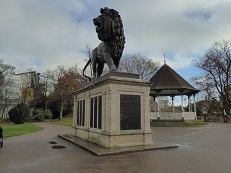 |
|
1.2 Victoria Gate and War Memorial The Victoria Gate is one of several Reading features built to commemorate Jubilees for Queen Victoria. In 1897 Victoria celebrated her sixtieth year as monarch, and these gates, at the main entrance to Forbury Gardens, were placed here in her honour. |
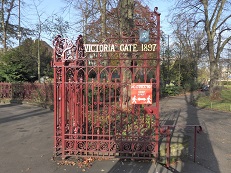 |
|
1.3 St Laurence's Churchyard Wall The churchyard for St Laurence's church was established in the mid-16th century, after the dissolution of Reading Abbey resulted in the loss of the burial site there. The wall that forms the boundary of the churchyard is partly the original tudor wall and partly a later, 18th century, construction. The gateway shown in the thumbnail image link is towards the North end of the wall. |
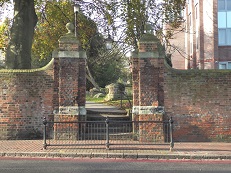 |
|
1.4 St Laurence's Church St Laurence's Church was built at the same time as Reading Abbey to serve the population for this part of Reading. The original church was constructed during the 12th century, then over the following centuries it was considerably extended. A detailed desciption of the church can be found at British History Online. |
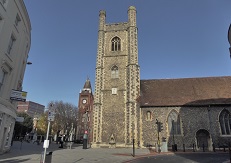 |
|
Map 1: Town Hall Square | |
|
After passing St Laurence's church on the south side, turn right into Town Hall Square. To reach the viewing point for Site 5, the Hospitium, pass round the West front of the church and into the passage along the North side. |
|
|
A short distance along this path, a plaque on the wall of the building opposite the church records a World War II bombing raid on the centre of Reading which left many people dead. Information about the raid can be seen on this Reading Museum website blog. |
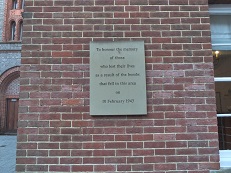 |
|
About 50m further along the path you reach the viewing point and Interpretation Panel for the Hospitium. |
|
|
1.5 Hospitium The Hospitium was the guesthouse for pilgrims visiting Reading Abbey. |
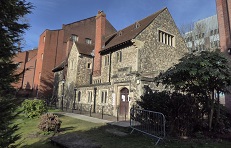 |
1.6a Reading Town Hall and 1.6b Reading Museum The Town Hall and Museum complex are an accretion of a hundred years of major development phases which took place between 1786 and 1897 on the site of the Hospitium of Reading Abbey. The construction phases were: the Small Town Hall; Alfred Waterhouse's Council Chamber, offices and clock tower; the concert Hall, museum and library; and finally the Art Gallery. |
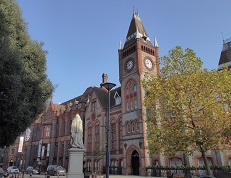 |
|
1.7 Statue of Queen Victoria One of several features in Reading marking Jubilees of Queen Victoria. The statue was sculpted in 1887 by George Simmonds to mark the 50th year of her reign. |
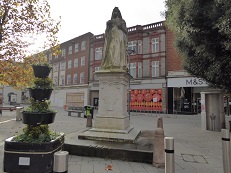 |
|
Map 1: Town Hall Square to Station Rd. | |
|
1.8 Listed buildings, 11-15 Friar St. This row of 18th and 19th century buildings with facades of light grey and red bricks looks out from behind bold twenty-first century signage paraphernalia. |
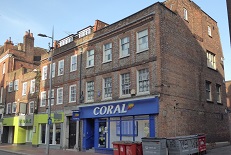 |
|
1.9 Listed buildings, 1-31 Queen Victoria St. The terracotta of the window surrounds and pillars of these impressive buildings stands out when viewed along the street. Viewed from Friar Street and Broad Street the yellow brick walls are seen to be equally conspicuous. |
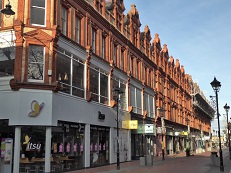 |
|
1.10 Listed building, 13-15 Station Rd. Built in 1903. This building has a facade intricately decorated in terracotta with a variety of geometrical shapes, in the words of the listing text "mixture of Baroque Art Nouveau and Flemish styles". Also displayed under the link is a nearby building, 3-5 Station Road, similarly adorned though on a less profuse scale. |
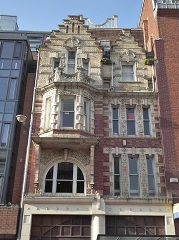 |
|
Map 1 . . Summary page for Map 2 |